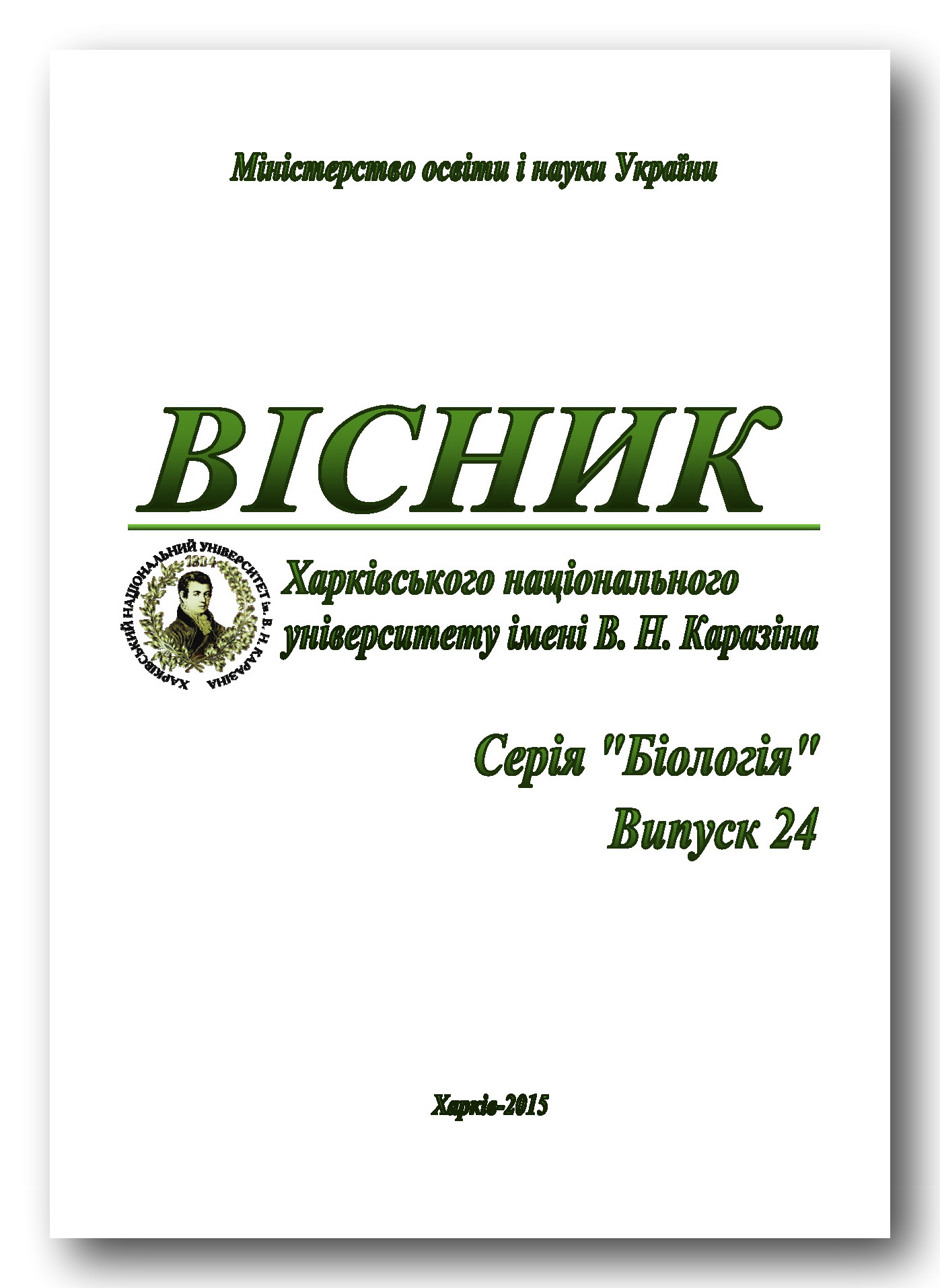The distribution of hyaluronan-binding activity of rats brain proteins under doxorubicin effect
Abstract
Using solid phase carbohydrate-enzyme analysis the study of hyaluronan-binding activity of brain proteins has been carried out in water-soluble, membrane and extracellular fractions obtained from different brain areas of Wistar rats. Doxorubicin has led to the change of protein affinity to hyalyronate depending on the area of brain and the cellular compartment, with the most pronounced effect in water-soluble fraction of cerebellum and extracellular fraction from cerebellum and hippocampus. The use of doxorubicin simultaneously with α-ketoglutarate has led partially to approximation of hyaluronan-binding proteins activity to the values of the norm but not in all areas of rats brain.
Downloads
References
Бакланова Я.В. Ушакова Г.О. Токсичні ефекти та біохімічний контроль наслідків антрациклінової терапії // Архів клінічної та експериментальної медицини. – 2013. – Т.22, №1. – С. 242‒248. /Baklanova Ya.V., Ushakova G.A. Toksychni effecty ta biochimichnyy control’ naslidkiv antratsyklinovoi terapii // Arkhiv clinichnoi ta eksperymental’noi medytsyny. – 2013. – T.22, №1. – S. 242–248./
Ananthanarayanan B., Kim Y., Kumar S. Elucidating the mechanobiology of malignant brain tumors using a brain matrix-mimetic hyaluronic acid hydrogel platform // Biomaterials. – 2011. – Vol.32 (31). – P. 7913–7923.
Dakshayani K.B., Subramanian P. Alpha-ketoglutarate modulates the circadian patterns of lipid peroxidation and antioxidant status during N-nitrosodiethylamine-induced hepatocarcinogenesis in rats // J. Med. Food. – 2006. – Vol.9. – P. 90–97.
Day A.J., Prestwich G.D. Hyaluronan-binding proteins: tying up the giant // The Journal of Biological Chemistry. – 2002. – Vol.277 (7). – P. 4585–4588.
Dolzhenko M.I., Lepekhin E.A., Berezin V.A. A novel methods for evaluation of carbohydrate-binding activity: enzyme-linked carbohydrate-binding assay (ELCBA) // International Journal of Biochemistry and Molecular Biology. – 1994. – Vol.34 (2). – Р. 261–271.
Dutta V. Chemotherapy, neurotoxicity, and cognitive changes in breast cancer // Journal of Cancer Research and Therapeutics. – 2011. – Vol.7 (3). – P. 264–269.
Entwistle J. Hall C.L., Turley E.A. HA receptors: regulators of signaling to the cytoskeleton // J. Cell. Biochem. – 1996. – Vol.61 (4). – P. 569–577.
Guptaa D., Tatorc C.H., Shoicheta M.S. Fast-gelling injectable blend of hyaluronan and methylcellulose for intrathecal, localized delivery to the injured spinal cord // Biomaterials. – 2006. – Vol.27 (11). – P. 2370–2379.
Harrison A.P., Pierzynowski S.G. Biological effects of 2-oxoglutarate with particular emphasis on the regulation of protein, mineral and lipid absorption/metabolism, muscle performance, kidney function, bone formation and cancerogenesis, all viewed from a healthy ageing perspective state of the art – review article // J. Physiol. Pharmacol. – 2008. – Vol.59. – Р. 91–106.
Itano N., Atsumi F., Sawai T. et al. Abnormal accumulation of hyaluronan matrix diminishes contact inhibition of cell growth and promotes cell migration // Proc. Natl. Acad. SCI. USA. – 2002. – Vol.19 (6). – P. 3609–3614.
Jiang D., Liang J., Noble P.W. Hyaluronan as an immune regulator in human diseases // Physiol. Rev. – 2011. – Vol.91 (1). – P. 221–264.
Kochlamazashvili G., Henneberger C., Bukalo O. et al. The extracellular matrix molecule hyaluronic acid regulates hippocampal synaptic plasticity by modulating postsynaptic l-type Ca(2+) channels // Neuron. – 2010. – Vol.15 (67). – P. 116–128.
Kovalenko T.N., Ushakova G.A., Osadchenko I. et al. The neuroprotective effect of 2-oxoglutarate in the experimental ischemia of hippocampus // J. PhysioL. Pharmacol. – 2011. – Vol.62 (2). – Р. 239–246.
Mellor L., Knudson C.B., Hida D. et al. Intracellular domain fragment of CD44 alters CD44 function in chondrocytes // J. Biol. Chem. – 2013. – Vol.6 (36). – P. 25838–25850.
Moore H.C. An overview of chemotherapy-related cognitive dysfunction, or 'chemobrain' // Oncology (Williston Park) – 2014. – Vol.28 (9). – P. 797–804.
Neilan T.G., Blake S.L., Ichinose F. et al. Disruption of nitric oxide synthase 3 protects against the cardiac injury, dysfunction, and mortality induced by doxorubicin // Circulation. – 2007. – Vol.116. – P. 506–514.
Rowlands D., Sugahara K., Kwok J.C. Glycosaminoglycans and glycomimetics in the central nervous System // Molecules. – 2015. – Vol.20 (3). ‒ P. 3527–3548.
Stěrba M., Popelová O., Vávrová A. et al. Oxidative stress, redox signaling, and metal chelation in anthracycline cardiotoxicity and pharmacological cardioprotection // Antioxid. Redox. Signal. – 2013. – Vol.10 (8). – P. 899–929.
Tulsawani R., Bhattacharya R. Effect of alpha-ketoglutarate on cyanide-induced biochemical alterations in rat brain and liver // Biomed. Environ. Sci. – 2006. – Vol.19. – Р. 61–66.
Vedunova M., Sakharnova T., Mitroshina E. et al. Seizure-like activity in hyaluronidase-treated dissociated hippocampal cultures // Front. Cell. Neuroscie. – 2013. – Vol.7. – P. 149–161.
Veiseh M., Turley E.A. Hyaluronan metabolism in remodeling extracellular matrix: probes for imaging and therapy of breast cancer // Integr. Biol. – 2011. – Vol.3. – P. 304–315.
Xie Y., Upton Z., Richards S. et al. Hyaluronic acid: evaluation as a potential delivery vehicle for vitronectin: growth factor complexes in wound healing applications // Journal of Controlled Release. – 2011. – Vol.153 (3). – P. 225–240.
Yadav A.K., Mishra P., Mishra A.K. et al. Development and characterization of hyaluronic acid-anchored PLGA nanoparticulate carriers of doxorubicin // Nanomedicine. – 2007. – Vol.3 (4). – P. 246–257.
Yung S., Chan T.M. Pathophysiology of the peritoneal membrane during peritoneal dialysis: the role of hyaluronan // Hindawi Publishing Corporation Journal of Biomedicine and Biotechnology. – 2011. – Vol.2011. – P. 1–11.
Yasuhara O., Akiyama H., McGeer E.G. et al. Immunohistochemical localization of hyaluronic acid in rat and human brain // Brain Res. – 1994. – Vol.28. – P. 269–282.
Authors retain copyright of their work and grant the journal the right of its first publication under the terms of the Creative Commons Attribution License 4.0 International (CC BY 4.0), that allows others to share the work with an acknowledgement of the work's authorship.




